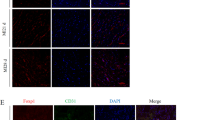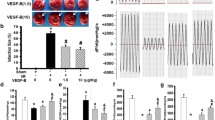Abstract
Neovascularization plays pivotal role in ischemic heart failure; however, it is unclear in non-ischemic heart failure. Non-ischemic heart failure was induced by chronic rapid right ventricular pacing at 200 beats/min, respectively, for 3 and 6 weeks in 12 dogs. Sham-operation was performed in another 6 dogs as control. Three-week tachycardia pacing could induce mild/moderate heart failure and 6-week pacing could induce severe heart failure. Pan-microvessel density (MVD) was assessed by CD31 and neovascularization density was assessed by CD105. Mean CD31-MVD and CD105-MVD were significantly increased after 3-week pacing. However, CD105-MVD was significantly decreased by 80 % in 6-week pacing group compared with 3-week pacing group, whereas CD31-MVD was only decreased slightly (15 %; P < 0.05). Myocardial proangiogenic factor stromal cell-derived factor 1 (SDF-1), hypoxia-inducible factors 1α (HIF-1α, a transcription factor which could regulate SDF-1 expression), serum SDF-1 levels and circulating EPC mobilization were greatly elevated after 3-week pacing but nearly returned to baseline level after 6-week pacing, which were in accordance with the changes of neovascularization levels assessed by CD105. Angiogenesis and migrating ability of EPCs were enhanced after stimulation of SDF-1, which could be abolished by pretreatment with SDF-1 receptor antagonist AMD3100. In addition, angiogenesis and migrating functions of EPCs were significantly enhanced by the serum from 3-week pacing dogs, but had much weaker response to the serum from 6-week pacing dogs. In conclusion, tachycardia pacing-induced non-ischemic heart failure, promoted myocardial neovascularization and mobilized circulating EPCs, which might be mediated partly through SDF-1 pathway.





Similar content being viewed by others
References
Yang HY, Chiu WC, Huang JH, Hsu CY, Lin YK, Chen YJ (2013) Analysis of 10-year nationwide population-based data on sex differences in hospitalization for heart failure. Heart Vessels 28:721–727
Cao Y, Hong A, Schulten H, Post MJ (2005) Update on therapeutic neovascularization. Cardiovasc Res 65:639–648
Shimano M, Ouchi N, Shibata R, Ohashi K, Pimentel DR, Murohara T, Walsh K (2010) Adiponectin deficiency exacerbates cardiac dysfunction following pressure overload through disruption of an AMPK-dependent angiogenic response. J Mol Cell Cardiol 49:210–220
Shyu KG, Lu MJ, Chang H, Sun HY, Wang BW, Kuan P (2005) Carvedilol modulates the expression of hypoxia-inducible factor-1alpha and vascular endothelial growth factor in a rat model of volume-overload heart failure. J Card Fail 11:152–159
Zeisberg EM, Tarnavski O, Zeisberg M, Dorfman AL, McMullen JR, Gustafsson E, Chandraker A, Yuan X, Pu WT, Roberts AB, Neilson EG, Sayegh MH, Izumo S, Kalluri R (2007) Endothelial-to-mesenchymal transition contributes to cardiac fibrosis. Nat Med 13:952–961
Hasenfuss G (1998) Animal models of human cardiovascular disease, heart failure and hypertrophy. Cardiovasc Res 39:60–76
Shiojima I, Sato K, Izumiya Y, Schiekofer S, Ito M, Liao R, Colucci WS, Walsh K (2005) Disruption of coordinated cardiac hypertrophy and angiogenesis contributes to the transition to heart failure. J Clin Invest 115:2108–2118
Tirziu D, Chorianopoulos E, Moodie KL, Palac RT, Zhuang ZW, Tjwa M, Roncal C, Eriksson U, Fu Q, Elfenbein A, Hall AE, Carmeliet P, Moons L, Simons M (2007) Myocardial hypertrophy in the absence of external stimuli is induced by angiogenesis in mice. J Clin Invest 117:3188–3197
Wilson JR, Douglas P, Hickey WF, Lanoce V, Ferraro N, Muhammad A, Reichek N (1987) Experimental congestive heart failure produced by rapid ventricular pacing in the dog: cardiac effects. Circulation 75:857–867
Harada M, Hojo M, Kamiya K, Kadomatsu K, Murohara T, Kodama I, Horiba M (2014) Exogenous midkine administration prevents cardiac remodeling in pacing-induced congestive heart failure of rabbits. Heart Vessels. doi:10.1007/s00380-014-0569-5
Kawamoto A, Gwon HC, Iwaguro H, Yamaguchi JI, Uchida S, Masuda H, Silver M, Ma H, Kearney M, Isner JM, Asahara T (2001) Therapeutic potential of ex vivo expanded endothelial progenitor cells for myocardial ischemia. Circulation 103:634–637
Schuh A, Liehn EA, Sasse A, Hristov M, Sobota R, Kelm M, Merx MW, Weber C (2008) Transplantation of endothelial progenitor cells improves neovascularization and left ventricular function after myocardial infarction in a rat model. Basic Res Cardiol 103:69–77
Michowitz Y, Goldstein E, Wexler D, Sheps D, Keren G, George J (2007) Circulating endothelial progenitor cells and clinical outcome in patients with congestive heart failure. Heart 93:1046–1050
Valgimigli M, Rigolin GM, Fucili A, Porta MD, Soukhomovskaia O, Malagutti P, Bugli AM, Bragotti LZ, Francolini G, Mauro E, Castoldi G, Ferrari R (2004) CD34+ and endothelial progenitor cells in patients with various degrees of congestive heart failure. Circulation 110:1209–1212
Geft D, Schwartzenberg S, Rogowsky O, Finkelstein A, Ablin J, Maysel-Auslender S, Wexler D, Keren G, George J (2008) Circulating apoptotic progenitor cells in patients with congestive heart failure. PLoS One 3:e3238
Nonaka-Sarukawa M, Yamamoto K, Aoki H, Nishimura Y, Tomizawa H, Ichida M, Eizawa T, Muroi K, Ikeda U, Shimada K (2007) Circulating endothelial progenitor cells in congestive heart failure. Int J Cardiol 119:344–348
Zhou SX, Lei J, Fang C, Zhang YL, Wang JF (2009) Ventricular electrophysiology in congestive heart failure and its correlation with heart rate variability and baroreflex sensitivity: a canine model study. Europace 11:245–251
Duff SE, Li C, Garland JM, Kumar S (2003) CD105 is important for angiogenesis: evidence and potential applications. Faseb J 17:984–992
Tanaka F, Otake Y, Yanagihara K, Kawano Y, Miyahara R, Li M, Yamada T, Hanaoka N, Inui K, Wada H (2001) Evaluation of angiogenesis in non-small cell lung cancer: comparison between anti-CD34 antibody and anti-CD105 antibody. Clin Cancer Res 7:3410–3415
Mineo TC, Ambrogi V, Baldi A, Rabitti C, Bollero P, Vincenzi B, Tonini G (2004) Prognostic impact of VEGF, CD31, CD34, and CD105 expression and tumour vessel invasion after radical surgery for IB-IIA non-small cell lung cancer. J Clin Pathol 57:591–597
Weidner N, Semple JP, Welch WR, Folkman J (1991) Tumor angiogenesis and metastasis—correlation in invasive breast carcinoma. N Engl J Med 324:1–8
Boilson BA, Larsen K, Harbuzariu A, Delacroix S, Korinek J, Froehlich H, Bailey KR, Scott CG, Shapiro BP, Boerrigter G, Chen HH, Redfield MM, Burnett JJ, Simari RD (2010) Regulation of circulating progenitor cells in left ventricular dysfunction. Circ Heart Fail 3:635–642
Wu H, Riha GM, Yang H, Li M, Yao Q, Chen C (2005) Differentiation and proliferation of endothelial progenitor cells from canine peripheral blood mononuclear cells. J Surg Res 126:193–198
Smith RR, Barile L, Cho HC, Leppo MK, Hare JM, Messina E, Giacomello A, Abraham MR, Marban E (2007) Regenerative potential of cardiosphere-derived cells expanded from percutaneous endomyocardial biopsy specimens. Circulation 115:896–908
Ceradini DJ, Kulkarni AR, Callaghan MJ, Tepper OM, Bastidas N, Kleinman ME, Capla JM, Galiano RD, Levine JP, Gurtner GC (2004) Progenitor cell trafficking is regulated by hypoxic gradients through HIF-1 induction of SDF-1. Nat Med 10:858–864
Roberts N, Xiao Q, Weir G, Xu Q, Jahangiri M (2007) Endothelial progenitor cells are mobilized after cardiac surgery. Ann Thorac Surg 83:598–605
Fukuda S, Kaga S, Sasaki H, Zhan L, Zhu L, Otani H, Kalfin R, Das DK, Maulik N (2004) Angiogenic signal triggered by ischemic stress induces myocardial repair in rat during chronic infarction. J Mol Cell Cardiol 36:547–559
van Bilsen M, van Nieuwenhoven FA, van der Vusse GJ (2009) Metabolic remodelling of the failing heart: beneficial or detrimental? Cardiovasc Res 81:420–428
Ekelund UE, Harrison RW, Shokek O, Thakkar RN, Tunin RS, Senzaki H, Kass DA, Marban E, Hare JM (1999) Intravenous allopurinol decreases myocardial oxygen consumption and increases mechanical efficiency in dogs with pacing-induced heart failure. Circ Res 85:437–445
Hickey MM, Simon MC (2006) Regulation of angiogenesis by hypoxia and hypoxia-inducible factors. Curr Top Dev Biol 76:217–257
Yamaguchi J, Kusano KF, Masuo O, Kawamoto A, Silver M, Murasawa S, Bosch-Marce M, Masuda H, Losordo DW, Isner JM, Asahara T (2003) Stromal cell-derived factor-1 effects on ex vivo expanded endothelial progenitor cell recruitment for ischemic neovascularization. Circulation 107:1322–1328
Salcedo R, Oppenheim JJ (2003) Role of chemokines in angiogenesis: cXCL12/SDF-1 and CXCR4 interaction, a key regulator of endothelial cell responses. Microcirculation 10:359–370
Rossig L, Haendeler J, Mallat Z, Hugel B, Freyssinet JM, Tedgui A, Dimmeler S, Zeiher AM (2000) Congestive heart failure induces endothelial cell apoptosis: protective role of carvedilol. J Am Coll Cardiol 36:2081–2089
Acknowledgments
This study was supported by a grant from the National Natural Science Foundation of China (No. 81100101 and No. 81270212), Program for New Century Excellent Talents in University (NCET-13-0606), and Guangdong Province Natural Science Fund (Nos. S2013010014011 and 10451008901004814).
Conflict of interest
The authors declare that they have no conflict of interest.
Author information
Authors and Affiliations
Corresponding author
Additional information
J. Mai, F. Wang and Q. Qiu have contributed equally.
Electronic supplementary material
Below is the link to the electronic supplementary material.
Rights and permissions
About this article
Cite this article
Mai, J., Wang, F., Qiu, Q. et al. Tachycardia pacing induces myocardial neovascularization and mobilizes circulating endothelial progenitor cells partly via SDF-1 pathway in canines. Heart Vessels 31, 230–240 (2016). https://doi.org/10.1007/s00380-014-0613-5
Received:
Accepted:
Published:
Issue Date:
DOI: https://doi.org/10.1007/s00380-014-0613-5




